Fresh oil road sign meaning – When you encounter a “Fresh Oil” road sign, heed its warning: the road ahead is slicker than a politician’s promise. Understanding the meaning of this sign is crucial for ensuring your safety and avoiding potential hazards on freshly oiled roads.
This comprehensive guide delves into the significance of the “Fresh Oil” road sign, its variations, and the impact of fresh oil on road conditions. We’ll also explore safety precautions, legal implications, and alternative road maintenance methods to keep you informed and prepared.
Introduction to Fresh Oil Road Sign Meaning
Road signs play a crucial role in ensuring the safety and smooth flow of traffic. They provide essential information and guidance to drivers, helping them navigate the roads safely and efficiently.
Among the various road signs, the “Fresh Oil” sign holds particular significance. It serves as a warning to drivers, indicating that the road surface ahead has recently been treated with oil or other slippery substances.
Potential Hazards
Driving on freshly oiled roads poses potential hazards to drivers. The oil can create a slippery surface, reducing tire traction and increasing the risk of accidents. Additionally, the fumes from the oil can be irritating to the eyes and respiratory system.
Characteristics and Design of the Fresh Oil Road Sign
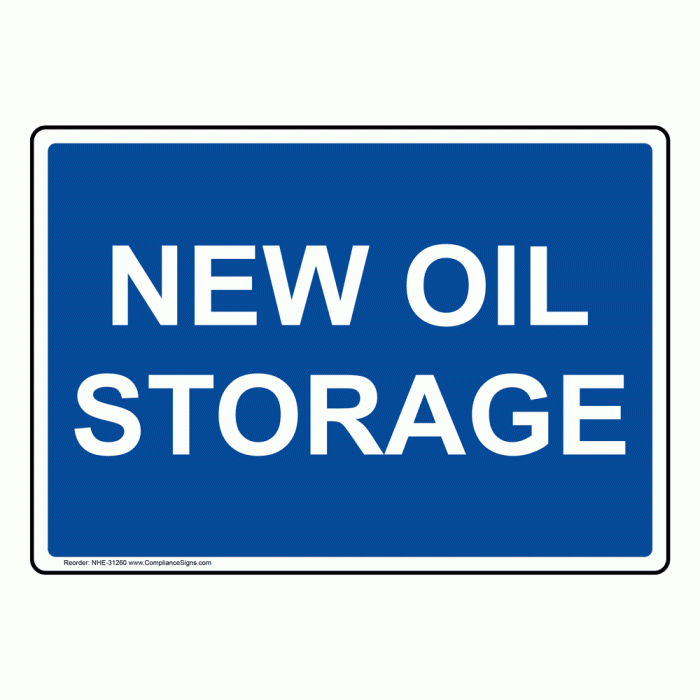
The “Fresh Oil” road sign is a temporary traffic sign used to warn drivers of recently applied oil or tar on the road surface. Its distinctive design and color scheme convey a clear message to motorists to proceed with caution.
The sign typically features a yellow background with black lettering and a black border. The shape of the sign is usually rectangular or square, with the words “Fresh Oil” prominently displayed in bold letters. Some variations of the sign may include additional symbols or graphics, such as a caution symbol or an image of a slippery road surface.
Variations in Sign Design
The design of the “Fresh Oil” road sign may vary slightly across different jurisdictions. In some regions, the sign may have a yellow diamond shape instead of a rectangle or square. The color scheme and lettering may also vary, but the overall message and purpose of the sign remain consistent.
If you see a fresh oil road sign, it means that the road has been recently resurfaced and is slippery when wet. To learn more about chemical structures, you can refer to the ch3s o ch3 lewis structure . Remember to drive carefully on fresh oil roads to avoid accidents.
Variations and Modifications of the Fresh Oil Road Sign
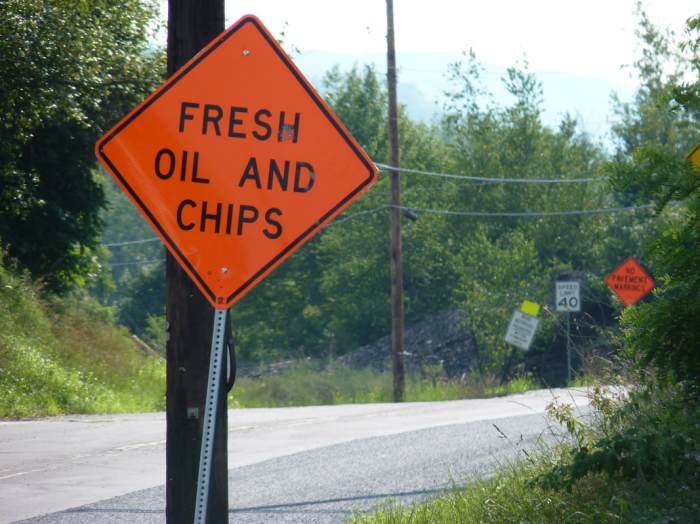
The standard “Fresh Oil” road sign is commonly recognized and understood by drivers. However, there are variations and modifications of this sign used in specific situations or to enhance its visibility and effectiveness.
Temporary or portable “Fresh Oil” signs are used in construction or maintenance zones where fresh oil has been applied to the road surface. These signs are typically smaller and more portable than the standard sign and can be easily moved or placed in strategic locations to alert drivers.
Innovative and Alternative Designs, Fresh oil road sign meaning
In some cases, innovative or alternative designs are used to enhance the visibility and effectiveness of “Fresh Oil” road signs. These designs may include:
- Reflective materials:Signs made with reflective materials increase visibility at night or in low-light conditions, making them more noticeable to drivers.
- LED lighting:LED lights can be incorporated into signs to provide additional illumination, particularly at night or in areas with poor lighting.
- Dynamic displays:Dynamic displays can be used to show real-time information, such as the distance to the fresh oil area or the estimated time it will take for the oil to dry.
- Attention-grabbing colors:Bright or contrasting colors, such as fluorescent yellow or orange, can be used to make the sign more noticeable and attract drivers’ attention.
Impact of Fresh Oil on Road Conditions
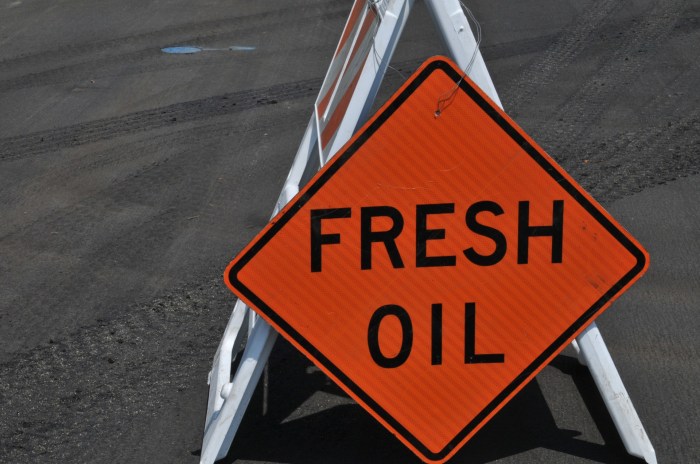
Freshly applied oil can have significant effects on road surfaces, impacting driving conditions and safety. It introduces reduced traction and increased slipperiness, posing risks and hazards for drivers and pedestrians.
Reduced visibility is another concern, as the oil can create a reflective surface that impairs drivers’ ability to see clearly. This can lead to delayed reactions and increased braking distances, further exacerbating the risks associated with driving on freshly oiled roads.
Examples of Accidents
Numerous accidents and incidents have occurred due to driving on freshly oiled roads. In 2021, a multi-vehicle pile-up in California was attributed to the slippery conditions caused by fresh oil, resulting in several injuries and property damage.
Safety Precautions and Driving Techniques
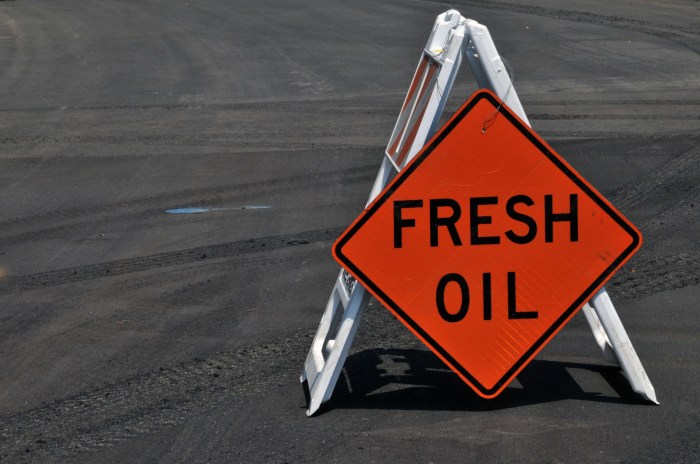
When encountering freshly oiled roads, adhering to specific safety precautions and driving techniques is crucial to ensure a safe and controlled driving experience. These measures involve reducing speed, maintaining a safe following distance, and avoiding sudden maneuvers.
Speed Reduction
Reducing speed is paramount on freshly oiled roads. The slippery surface significantly reduces tire grip, making it challenging to maintain control at higher speeds. By slowing down, drivers can increase their reaction time and provide a greater margin for error in case of unexpected situations.
Safe Following Distance
Maintaining a safe following distance behind other vehicles is essential. The reduced traction on oiled roads increases the stopping distance, making it necessary to leave ample space between vehicles. This allows drivers to react appropriately to any sudden stops or maneuvers.
Avoiding Sudden Maneuvers
Sudden maneuvers, such as急转弯 or 急刹车, should be avoided on freshly oiled roads. These actions can cause the vehicle to lose control due to the slippery surface. Smooth and gradual maneuvers are recommended to maintain stability and prevent skids.
Handling Slippery Conditions
In the event of a skid, it is important to remain calm and avoid overcorrecting. Gently steering in the direction of the skid and gradually releasing the accelerator can help regain control. Additionally, applying the brakes too forcefully can worsen the situation, so it is advisable to use light and intermittent braking.
Enforcement and Legal Implications
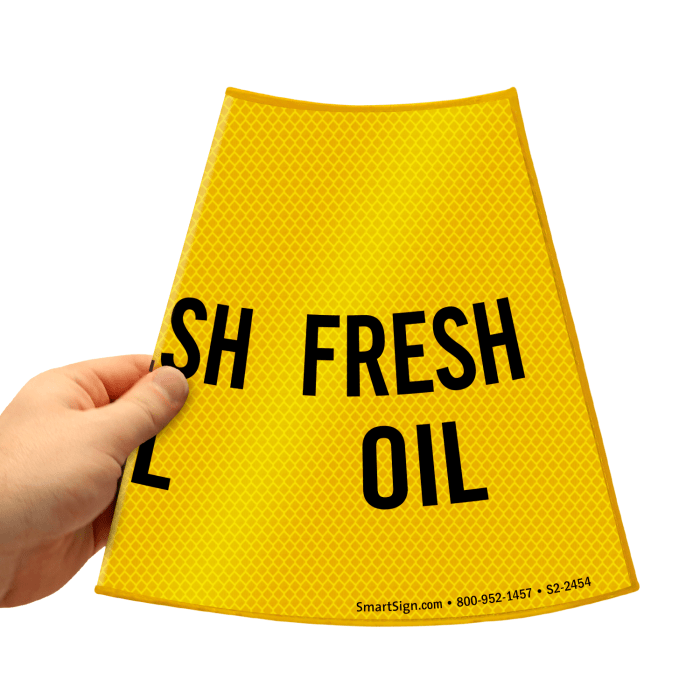
Ignoring or disobeying “Fresh Oil” road signs carries serious legal implications. Drivers who violate traffic laws related to driving on freshly oiled roads face penalties and consequences.
Penalties for violating these laws vary depending on the jurisdiction. In many areas, drivers may receive fines, points on their driving record, or even have their licenses suspended or revoked.
Successful Enforcement Measures
- Increased police patrols and enforcement efforts during road maintenance projects.
- Public awareness campaigns to educate drivers about the dangers of driving on fresh oil.
- Installation of speed bumps or other traffic calming measures to slow down traffic and prevent accidents.
Alternatives to Fresh Oil and Road Maintenance: Fresh Oil Road Sign Meaning

Fresh oil application, while effective, can be disruptive and costly. Therefore, exploring alternative methods for road maintenance that minimize the need for frequent oil application is crucial. These alternatives offer advantages such as extended road life, reduced maintenance costs, and improved driving conditions.
Sealcoating
Sealcoating involves applying a thin layer of asphalt emulsion or sealant to the road surface. This creates a protective barrier that prevents water penetration, reduces oxidation, and enhances skid resistance. Sealcoating extends the life of the road, reducing the need for major repairs or fresh oil application.
Question Bank
What does the “Fresh Oil” road sign mean?
It indicates that the road surface has been recently oiled, making it slippery and hazardous.
What should I do when I see a “Fresh Oil” sign?
Reduce your speed, increase your following distance, and avoid sudden maneuvers.
What are the potential hazards of driving on freshly oiled roads?
Reduced traction, increased slipperiness, and decreased visibility and braking distance.